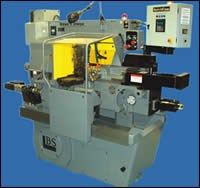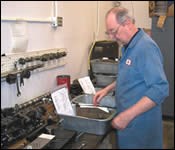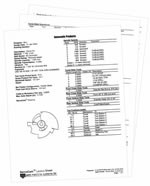Ingenuity Drives Single-Spindle Shop
Ideas for improvement are always welcomed here. Some of the most notable results have come from the merging of new technology with older, reliable equipment.
Some shop owners have a natural ability to implement strategies that bring their companies to the next level. After all, the goal is not only to survive, but to flourish in an industry that is increasingly competitive. Part of what it takes to hit these high marks comes from making the most of what one has. This is true across the board, in life as well as in the screw machine industry. However, one place it’s glaringly obvious is in a shop that finds ways to not only survive with old, yet reliably productive equipment, but to increase productivity dramatically.
Joel Gregory, president of Automatic Products Corporation (Kent, Washington), is one such leader, guiding his company with an attitude that enough is never enough. He sees the importance of always looking for the next way to improve and encourages his employees to find new and better ways to make parts.
Featured Content
Driving Growth
In 1984, Mr. Gregory started his business in his garage with a belt-drive #0G Brown & Sharpe, a Montgomery Ward bench lathe, a drill press and a belt sander, running parts after getting home from working his “real job.” He would also lease machine time at his other company for operations he couldn’t do at home. He never set out with a master plan for his business; it just evolved. However, with a limited number of screw machine shops in the area, this niche market called for a strategy of supporting the customers. This goal has driven growth for the company.
Eventually, Mr. Gregory was able to grow the business to the point where he could move into a small facility—2,500 square feet that he split with a business associate. He continued to buy machines and land jobs, and finally started taking on employees of his own. Four moves and 22 years later, he finds himself in his current location of 26,000 feet, busting at the seams and looking at options for almost doubling his square footage once again.
The company specializes in a broad range of markets, supplying parts for automotive aftermarket, recreational vehicles, aircraft, heavy equipment, trucking, medical and computer/electronics. This range has been beneficial because the company is not affected as much by cycles. The company is currently running two shifts and continues to steadily grow.
The workhorse for Automatic Products has been its lineup of Brown & Sharpe single-spindle automatics. While the shop is fully equipped with 11 CNC turning centers, seven machining centers, and an array of other milling, grinding and test equipment, the 16 Brownies on the floor continue to crank out a large portion of the ordered parts. Although these machines are old, they are also reliable. Capitalizing on his never-ending quest for improvement, Mr. Gregory has found a way to make them more productive than ever before.
Servodriven
In 1999, Greg Knight, VP of sales for AMT Machine Systems (Columbus, Ohio), contacted Mr. Gregory regarding AMT’s ServoCam system, designed to combine the versatility of CNC controls with the speed and reliability of Brown & Sharpe screw machines. At the time, Mr. Gregory felt he had his whole cam process completely honed. He had charted the company’s complete processes and wasn’t anxious to make a change. However, he likes to keep an open mind, and he always had it in the back of his mind that it would be nice to not have to deal with the cams. He saw the potential of the ServoCam turret slide system, but delayed the decision to make the change until AMT had added more features.
Within a year, AMT had added the AutoTripper feature (currently available on all Ultramatics) to the ServoCam upgrades. This option automates the tripping of the tool turret, spindle clutch, bar feeder and the part deflector, as well as controlling the base clutch on four-speed machines. The manual trip-dog setting is eliminated. Timing is precise enough to allow indexing and feed times to be cut significantly, and setup time is also reduced.
The new option was enough to get Mr. Gregory to give the ServoCam with AutoTrippers a try, and the first system was installed at Automatic Products on a 1 5/8 #2 Ultramatic. According to Mr. Knight, “Joel has always had orders in for things we don’t have yet, ready to be the first customer. They received the first production AutoTripper system, which he installed himself.”
With the success of this first system, the company started buying more, three or four at a time. Now, with 13 ServoCam upgrades, Automatic Products is a confirmed believer in the concept. According to Mr. Gregory, “We’ve seen much better than 20-percent cycle reduction, and in many jobs, we’ve seen as much as 30 and 40 percent. Much of the success is because of the ability to very easily and quickly fine-tune a job.” He says he can view a job and see adjustments that could be made for feeds, make the change and within a few minutes, be up and going again. “It’s even more noticeable on particularly long parts where you’re drilling deep holes,” he says.
The Payoff
The main benefits that ServoCam equipment has brought to Automatic Products are faster cycle times, precise threading and tapping, numeric tool length adjustments and the ability to quickly and easily modify part cycles. The company has seen a net production increase of almost 60 percent with no increase in labor. Jobs that originally ran as two operations now can run complete on the Brown & Sharpe machines in a fraction of the time. Mr. Gregory says they can try aggressive feed rates with no penalty, and if they are too much, they dial them back.
The strategy behind the servodriven tool slide is to eliminate the wasted time of the follower rolling over the edges of the lobes, as with a cam-driven slide. This non-cutting time typically constitutes up to 40 percent of the part cycle. A CNC screw machine could eliminate secondary operations and save valuable cutting time on high-precision, complex parts, but some parts are well-suited for the Brownies. Mr. Gregory understands the machines very well and has a knack for determining what parts will run best on which machines.
Why It’s Worth It
According to Mr. Gregory, “One thing that AMT has done well is to keep the programming of the ServoCam system uncomplicated. An operator with only basic knowledge of running a Brown & Sharpe machine, with only a small amount of training, can now program the machine. It’s not like learning a whole G code.” Initially, the operators at Automatic Products were hesitant, but they adapted very fast.
Beyond the easy operation of the system, Mr. Gregory also feels that the tolerances that the machine holds are much better now. He says when they put the ServoCam upgrades on, they also went ahead and rebuilt the machines. “A lot of people would just throw them on the machines. If you’re not holding good concentricity, ServoCams aren’t going to help that at all.” Concentricity problems typically stem from a spindle bearing issue that a ServoCam system isn’t going to address. However, it does replace a lot of mechanics in the cam portion of the machine—parts that often wear out and require regular maintenance. Mr. Gregory says, “The servos have taken the guesswork out of much of the maintenance. If there’s a length problem, we no longer have to investigate the roller, or a pin in the mechanism, or the adjustment of the withdrawal cam. We know it’s a collet or feed finger issue. Length problems have pretty much completely gone away. We can now hold two thousandths on length without a problem on the feed out.”
When a job is running, the ServoCam system allows changes to the cam layout in as little as 5 minutes. If changes to the tooling are required, the job can be up and running in less than 30 minutes. With hard cams, though, Mr. Gregory says these types of changes would take more than a week. “To do it right and have a repeatable process down the road, there would be an hour and a half to 2 hours on the layout, depending on the complexity. Then it would take at least a week to have a good set of heat-treated cams cut and shipped out to Seattle.”
Down The Road
AMT continues product development and has spent the last few years on a new control system designed to overcome some limitations of conventional CNC control systems. The basic building blocks of the new system are “intelligent servomotors.” Each intelligent servomotor contains its own power supply, servo-amplifier and motion-control computer. More than 100 intelligent servomotors can be networked together to form a single integrated machine-control system.
Because adding intelligent servomotors to a system automatically increases the amount of computer power available, they can be beneficial in controlling machines with many motion axes. In comparison with a conventional CNC control system, a network of intelligent servomotors can also provide higher system reliability and lower production costs, because it has only about 50 percent of the cable interconnections. The UltraTurn CNC conversion for Brown & Sharpes is the first application of this new control system, proving out the technology in a very demanding machine tool application.
With the basic control system now deployed, AMT is currently working on additional upgrades to Brown & Sharpe machines. These upgrades will eliminate more of the old mechanical logic and provide higher metal removal rates. To bring the benefits of the new control-system technology to the new machine market, AMT will be looking for partners with expertise in building machine tools.
As new options become available, Mr. Gregory keeps watch. He has enjoyed seeing the progress of the ServoCam system and has reaped the rewards of expanded production that the system has brought to his shop. When Mr. Knight comes knocking with the latest upgrade that will help Automatic Products, he will, no doubt, be first in line to take advantage of it.
RELATED CONTENT
-
Precision Machining Technology Moving Shops Forward
New equipment and software continue to be developed to support the needs of production machine shops like yours. Here’s a sample of technology now on the market that can help you grow your operation and become more efficient.
-
Production Turning to CNC
The precision production turning industry is trending away from cam-actuated automatics. While limited legacy machine capability and skilled labor resources are two large factors, economics is the primary driver.
-
Turning Machines Help Firearms Supplier Achieve Rapid Growth
Working closely with its machine tool supplier, this firearms manufacturer has quickly expanded its lineup of turning machines to deliver quality products and faster delivery.











